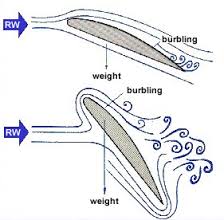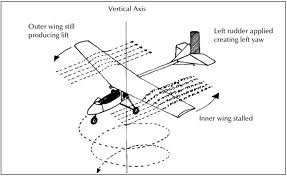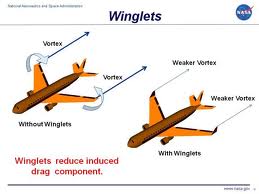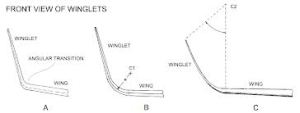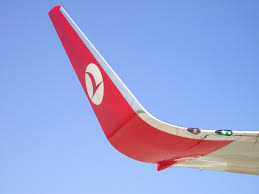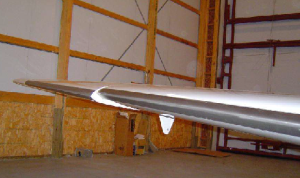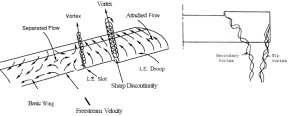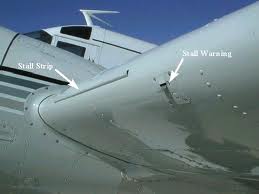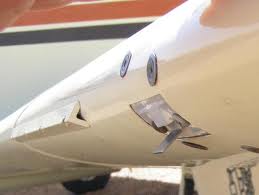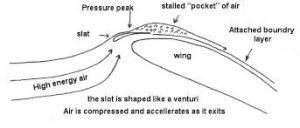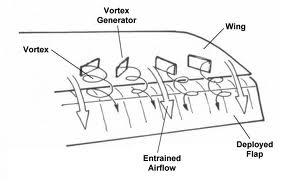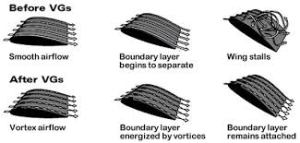IMPROVING AIRCRAFT STALL CHARACTERISTICS WITH FIXED DEVICES
Stalls and Spins
Stalls and resulting spins have caused aircraft accidents since the beginning of flight. Even though airplanes have evolved to have better stall characteristics, stalls and spins continue to be a leading cause of accidents.
A stall occurs when airflow separates from all or part of the upper surface of a wing, resulting in sudden loss of lift. This is caused by exceeding the critical angle of attack (angle of attack is the angle between the relative wind and the chord line of the airfoil).SEE FIG.
Below the critical angle, airflow over the wing surface is relatively smooth. Above the critical angle, the thin layer of air above the wing, or “boundary layer,” becomes turbulent and separates from the airfoil Lift is destroyed and drag increases, causing the aircraft to rapidly lose altitude. Pilots are trained to recover from this condition. However, if the stall occurs too low to the ground, there may not be enough altitude to recover.Stalls are usually associated with slow flight in a nose-up attitude, but they can occur at any airspeed or attitude.
FIG- aircraft under spin
Spins are of even greater concern because recovery requires more altitude and more actions on the part of the pilot. Simply stated, a spin is an autorotation resulting from one side of the wing stalling more than the other. Spins cause rapid loss of altitude. If the pilot does not recover, the aircraft will spin into the ground. Aircraft design affects the ease of entering and recovering from spins. Adding devices to improve stall characteristics will generally reduce spin-related accidents; preventing a stall or making it gentler can reduce accidental spins. Straight-wing aircraft must stall before they will spin (swept-wing aircraft do not necessarily have to stall first) .
Favorable Stall Characteristics
- Aircraft are designed to have the most favorable stall characteristics possible given the compromises involved. A good aircraft should give the pilot adequate warning of the stall, stall gradually, and tend not to spin after the stall .
- This means the aircraft wing should stall at the roots first, rather than at the tips where the ailerons are located. (Stalling at the tips first renders the ailerons ineffective for roll control.) Usually a NEGATIVE twist, or “washout,” is built into the wings so that the tips are always at a lower angle of attack. However, this is not always enough to create good stall characteristics. Some aircraft require further modifications to the wing.
- In the interest of safety, several types of fixed devices can modify a basic wing in order to improve stall characteristics. These include winglets, leading edge cuffs, stall strips, stall fences, slots, and vortex generators.
Winglets
Winglets, which are vertical extensions of the wingtips, improve stall characteristics by reducing induced drag. This induced drag comes from high pressure air under the wings flowing around the tips to the lower pressure area above, creating vortices. Winglets redistribute the intensity of wingtip vortices over a larger area. They increase the maximum coefficient of lift, resulting in a lower stall speed.
NASA studied the effect of winglets on the performance and handling qualities of aircraft. Using windtunnels, NASA tested two versions of a model airplane: one with winglets and one without. At stall, the airplane without winglets tended to “roll off” and “drop a wing”. The airplane with winglets demonstrated improved stall characteristics. According to a NASA report, “The winglets appeared to prevent the wing tip from stalling first… reducing the tendency to roll off” . In another study during the fuel crisis of the 1970s, NASA aerodynamicist Richard Whitcomb found that winglets reduced drag by 20 percent. Less drag means faster stall recovery.
Winglets have disadvantages that may outweigh their advantages in some cases. They create interference drag at the junction between the wing and winglet. This drag offsets the induced drag reduction. Winglets also have a tendency to flutter.
Leading Edge Cuffs
- Leading edge cuffs are extensions that project forward and droop from the outboard sections of an aircraft’s wings.
- They divide a wing into two different airfoils. The outboard section, with the cuffs, has a lower angle of attack and continues flying while the inboard section stalls. This allows the ailerons to continue to be effective in the stall. Wing cuffs also increase the stalling angle of attack .
Cuff Creates a secondary vortex over the wing Prevents separated flow from propagating down the span Attached flow is maintained over the tip and aileron see fig below
The disadvantages of leading edge cuffs are that they complicate the wing design and cannot be easily added to an existing wing.
Stall Strips
- A simple way to make the inboard section of a wing stall first is to install a stall strip on the inboard leading edge.
- Stall strips are lengths of wedge-shaped metal, wood, or other material that run parallel to the leading edge.
- At high angles of attack, the strips disrupt the boundary layer behind them and cause a stall in that area . They have the added benefit of causing a more pronounced stall buffet, providing more warning to the pilot.
- Stall strips are very common, especially in homebuilt aircraft, because they are easily removed and reattached. Homebuilders can experiment by putting the strips in different locations and noting their effect on stall characteristics.
- Stall strips are also found on many production aircraft, such as the Mooney series and the Cirrus SR20 and SR22. Some aircraft use stall strips on only one wing in order to eliminate an asymmetric stalling pattern .
While stall strips often improve stall characteristics, they are not always a quick fix for an airplane with poor handling qualities.
Stall Fences
- Stall fences are another device to prevent wing tips from stalling before the roots.
- They are thin plates which project up from the wing and lie parallel to the aircraft’s axis of symmetry. Without these fences, a spanwise airflow along wings causes the boundary layer to thicken toward the wingtips, especially on swept-wing aircraft. This results in early boundary layer separation at the wingtips and loss of aileron control.
- Fences block spanwise airflow, preventing boundary layer buildup over the ailerons and thus improving stall characteristics .
- Stall fences are primarily found on swept-wing aircraft like business jets and fighters, but are also found on straight-winged general aviation aircraft. The Eagle 150 has a unique design featuring a main wing, a forward wing, and a horizontal stabilizer. Each side of the main wing has a stall fence, which according to the manufacturer “redirects the airflow to the ailerons, creating a re-energizing effect. This allows the pilot or student pilot full control at minimum speed, and even at the point of stall” (Eagle Aircraft).
Some aircraft have aerodynamic stall fences. These are not the typical vertical plates, but instead other devices which create the same effect. The Questair Venture kitplane has a small vertical slot on the leading edge of each wing; the airplane looks like it ran into a bandsaw. At high angles of attack, air flowing through this slot creates a trailing vortex that acts like a stall fence .the “rooster tail” of air creates turbulent, high pressure air that can “impede the spanwise advance of the stall” .
Whether the stall fence is a physical plate or an airflow barrier, this device combats the progression of a stall across a wing and helps keep air flowing over the ailerons.
Slots
- Fixed slots in aircraft wings are used to increase the maximum coefficient of lift and delay the stall.
- Slots are long holes near the leading edge of a wing that run parallel to the leading edge. At high angles of attack, slots route high pressure air near the stagnation region under the wing to the lower pressure region on top . (This rerouted air energizes the boundary layer and delays its separation. Slots allow the aircraft to reach a higher angle of attack before stalling.
- Slots greatly improve the performance of aircraft at high angles of attack, but they have disadvantages as well. They must be designed into the wing from the beginning; they cannot be retrofitted to improve a design.
- · They cause a higher stall angle, so the plane must approach in a nose-up attitude that decreases visibility .
- The main disadvantage is that slots create excessive drag during normal cruising flight . (A solution to that problem is the slat, which is a slot with a moveable cover.
Vortex Generators
The most common boundary layer control devices are vortex generators. These are tiny plates mounted near the leading edge of the wing, perpendicular to the surface . Vortex generators energize the boundary layer by mixing in high-energy air from outside the boundary layer . They delay airflow separation .
Conclusion
The devices discussed in this section can help warn the pilot of a stall, cause the airplane to stall more gently, and make the airplane resist spinning. They are added measures of safety that improve a basic wing. Small changes in airflow patterns over a wing can greatly improve aircraft handling qualities at high angle of attack.

